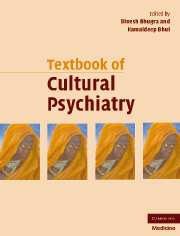Book contents
- Frontmatter
- Contents
- Contributors
- Foreword
- Preface
- Part I Theoretical background
- Part II Culture and mental health
- Part III Culture and mental disorders
- Part IV Theoretical aspects of management
- Part V Management with special groups
- Part VI Cultural research and training
- 41 Scope of cultural psychiatry
- 42 Coping with stressors: racism and migration
- Cultural psychiatry: the past and the future
- Index
- References
42 - Coping with stressors: racism and migration
from Part VI - Cultural research and training
Published online by Cambridge University Press: 11 August 2009
- Frontmatter
- Contents
- Contributors
- Foreword
- Preface
- Part I Theoretical background
- Part II Culture and mental health
- Part III Culture and mental disorders
- Part IV Theoretical aspects of management
- Part V Management with special groups
- Part VI Cultural research and training
- 41 Scope of cultural psychiatry
- 42 Coping with stressors: racism and migration
- Cultural psychiatry: the past and the future
- Index
- References
Summary
EDITORS' INTRODUCTION
Migration is the process by which individuals move to another culture or geographical area for a more or less permanent stay. The experiences of migration are as important in the genesis and maintenance of psychiatric disorders as is the process of migration itself. The views of many researchers and opinion makers do not move beyond the notions of racism, where almost every experience is seen as caused by/influenced by/coloured by racism. Racism is not a recent phenomenon although race itself was identified in the eighteenth century to differentiate between the colonized and their masters. However, Cicero in the fourth century BC was describing the British as lazy and stupid and advising his employer not to employ slaves from Britain. The inherent institutional racism in the Hindu caste system has been going on for millennia without clear clinical and research evidence that rates of psychiatric disorders are raised among lower castes.
Kelly and Feeney explore the challenges of racism and migration to patients, researchers and service providers. For patients, racism and migration do act as stressors to perpetuate (or precipitate) social problems. Their argument follows from epidemiological studies which demonstrate variable rates of various psychiatric illnesses in different ethnic groups. They highlight the ethical and methodological challenges for researchers, especially the problem of definition and cultural adaptation of research tools along with interpretation of findings outside the social and cultural context without community consultation. They point out that there is a paucity of studies examining the precise inter-relationship between biological factors and sociopolitical factors in the aetiology of specific psychiatric illnesses.
- Type
- Chapter
- Information
- Textbook of Cultural Psychiatry , pp. 550 - 560Publisher: Cambridge University PressPrint publication year: 2007
References
- 2
- Cited by



